
German Boy Choir Costumes: Schoeneberger Saengerknaben -- Uniform Chronology
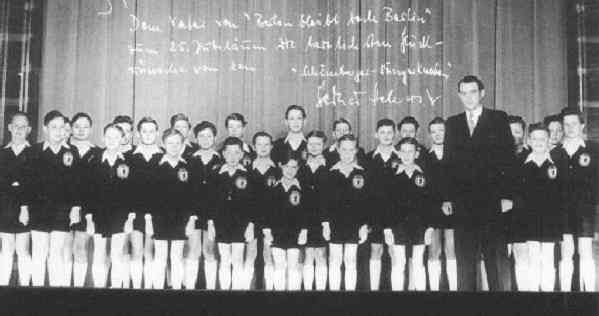
Figure 1.--The Schoeneberger Saengerknaben is pictured here, in 1951. This is as far as we know the Choir's first uniform, a short black jacket, white shirt, black short pants, white knee socks, and black leather shoes. The boys wore this outfit into the 1960s. Here is a close up.
|
|
The Schoeneberger Saengerknaben choristers has worn various uniforms over time. Most of the changes have been with the tops. The earliest uniform we have moted is a short jacket worn with a white shirt, matching black short pants, white knee socks, and mostly black leather shoes. Over time the top has changed. We also see vests and and V-neck sweaters. The short jackets ohitograph rather like the sweaters, so in many availble umages we are not entirely sure just what the boys are wearing. Occasionally the boys perforned just in white shirts without an added top. In the early years we see some diferences in footwear with a few boys wearing sandals. Other than the tops, since the early years when the uniform was first adopted there appears to have been little or no change in the uniform. The only basic uniform that HBC has noted is that the length of the short pants has varied. The boys in recent years have begun wearing longer shorts. In addition, they now have a travel uniform with long pants, but still perform in the short pants uniform that they have performed in during so many years. Few modern choirs have retained the same uniform over such a long period.
Since the early years when the Schoeneberger Saengerknaben first adopted a uniform, the top has changed, but the rest of the uniform has remained basically unhanged. The choir adopted a destinctive uniform of a small black jacket without lapels, an open-collar wjite shirt, matching black short pants, white knee aocks, and black leather shoes.
The jacket had a crest with a rampant/standing bear, the iconic symbol of Berlin. The uniform when it was adopted was based on common boys fashions. Short pants were still very common, including short pants suits. White knee socks were often used for a little more formal look. Short pants were very commonly worn in Germany during the 1940s and early-50s. They began to decline in the late-50s, but were still common boys wear. In many impages this photographs rather like a sweater. We do not think that sweaters were worn in the 50s, but are not enirely sure. We also see the boys wearing just their white shirts. The shirts with the embroidered choir crest. We are not sure the boys just wore the hirts in formal concerts.
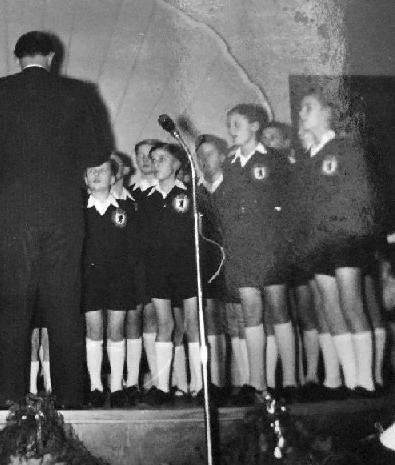
Figure 2.--Here we see the Schoeneberger Saengerknaben choristers we think in the early-1960s. It looks like they are wearing V-neck sweaters, but we think that they are wearing the same short jackets that they wore in the 1950s.
|
|
The 1960s
We are unsure about uniform changes during the 1960s. We believe we still see the boys wearing the same short jackets, at least in the early-60s. The photographic record is a little unclear. The images we have look like sweaters, but we believe hey a new short jackets. It is possible that the boys had both. We are just not real sure about this. We are not sure just when the change was made to the vest uniform that we see in the 1970s. We do not have dated images throughout the 1960s. The shift to vests could have been made in the late-60s. We see the boys wearing the vests in the eary-70s, but are not sure what was being worn in the late-60s. Here we are talking about the top only. The tops for the choir have changed over time. But the rest of the uniform, the short pnrs, white knee soclks and leather shoes has continued to be worn. We see occassional differences in the footwear. A few of the boys wear sandals. You cn see that here (figure 2). This is presumably because the choir provided the uniform, but the parents were responsible for the shoes. Thus there were a few boys that did not have the standard black oxfords. Sandals were still fairly common in the 60s.
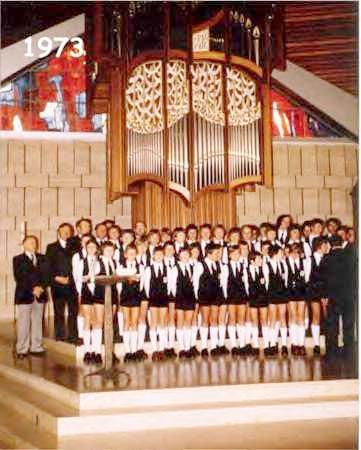
Figure 3.--Here we see what we believe to be the the Schoeneberger Saengerknaben choristers in 1973. We can make out the crest, but we think it is the Schoeneberger Saengerknaben. The are wearing the new vest uniform instead of a jacket. Notice that rather than open collars they are wearing black ties with the vests.
|
|
The 1970s
A major change in the choir uniform was made in the 1970s. We see the boys wearing the new vest uniforms at the beginning of the decade. We are not sure though just when they were first introduced, it could have been the late-60s. The short jackets were replaced with more informal vests. The vests had the same crest as the jackets. The images we have found are rather small and do not show the destinctive Berlin rampant bear crest clearly, but we believe thet are of the Schoeneberger Saengerknaben. Another change was the boys buttoned their collars and wore narrow black neck ties to go along with the black vests and shorts. Unlike jackets and sweaters, here it easy to tell the difference. We are not sure why the change was made. The vests were less expensive than the jackets. Presumably the Choir directors saw it as a more modern look. Boys in Germany and the rest of Europe by the 1970s were not wearing suits as commonly as was the case in earlier decades. And the vest was being worn in both Europe and America for dress occasions. It was a najor fashion trend that became common during the 70s. The vest was thus part of a greater informality, but more formal than just wearing white shirts. We do notice one image of the boys wearing white shirts without the vests, but we are not sure they gave forml concerts dresses in just the shirts. The open white shirts, short pants, white knee socks, and black leather shoes continued unchanged. We no longer see any boys wearing sandals.
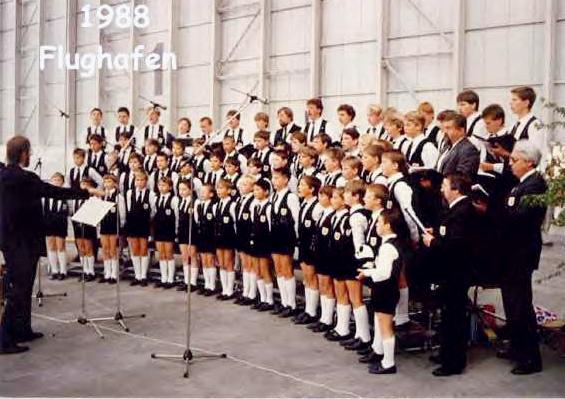
Figure 4.--Here we see the Schoeneberger Saengerknaben choristers at Flughfen in 1988. We think that ,eans a Frankfurt am Main nd not a genric airport. The boys are still wearing the vst uniform they wore in the 1970s. We can not see the destinctive rampt bear crests, but we think it is the Schoeneberger Saengerknaben
|
|
The 1980s
The boys continued to wear the vest uniform in the 1980s. As far as we can tell, the vest uniform was worn throughout the 1970s. We do not see any change at all throughout the decade. As far as we can tell, the boys ewore the vest uniform unchanged throughout the 1980s. We do not hve many images from the 1980s, but all the ones we have found show the boys perforing in the vest uniform. Unless the image is dated, we can not diufferentiuate betwwen the 1970s and 80s. The popularity of the vest in contempray fashion by the lte 80s was declining. This appears to have prompted a change in the uniform.
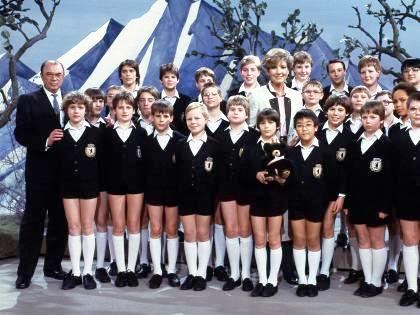
Figure 5.--Here we see another TV performnce by the Schoeneberger Saengerknaben choristers, we think in the early-1990s, although it is undated. Notice the Alpine back drop. The boys are wearing V-neck sweaters with their iconic rampant bear crest. They have gone back to open collars rather than the ties worn with the vests.
|
|
The 1990s
We see the boys wearing V-neck sweaers rather than vests in the 1990s. the boys also discaded the toes yhast they had worn with the vest uniform. Some boys appear to have worn cardigans as we seem to see some buttons. The only other basic uniform that HBC has noted is that the length of the short pants has varied. The boys in the 1990s began wearing longer shorts. In addition, they now have a travel uniform with long pants, but still perform in the short pants uniform that they have perfornmed in during so many years.
The 2000s
HBC knows of no uniform changes in the 2000s.
HBC

Navigate the Historic Boys' Clothing Web Site:
[About Us]
[Introduction]
[Activities]
[Biographies]
[Chronology]
[Clothing styles]
[Countries]
[Girls]
[Theatricals]
[Topics]
[Bibliographies]
[Contributions]
[FAQs]
[Glossaries]
[Images]
[Links]
[Registration]
[Tools]
[Boys' Clothing Home]
Navigate the Historic Boys' Clothing Web choir costume pages:
[Return to the Main Schoeneberger Saengerknaben choir uniform page]
Main choir page]
[Return to the Main national choir page]
[Australia]
[Austria]
[Belgium]
[Bulgaria]
[Canada]
[Denmark]
[England]
[France]
[Finland]
[Germany]
[Japan]
[Netherlands]
[Poland]
[South Africa]
[United States]
Navigate the Historic Boys' Clothing Web style pages:
[Short pants suits]
[Blazers]
[Collars]
[Lace collars]
[Ruffled collars]
[Eton collar]
[Fauntleroy suits]
[Sailor suits]
[Ring bearer/page costumes]
[First Communion suits]
Created: June 2, 2001
Last updated: 11:41 AM 4/24/2017







